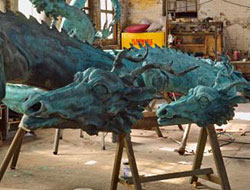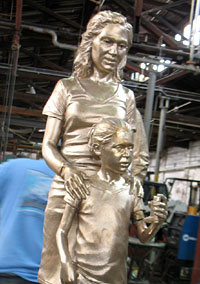Ward Elicker Casting: New Horizons Provide a Clearer Vision
 Working on the Chinatown bronze dragons
Working on the Chinatown bronze dragons Photograph courtesy of Ward Elicker
Ward Elicker Casting, based in Philadelphia, uses lost wax and lost foam investment processes to create incredible works of bronze. But large format casting is becoming a lost art. With 22 employees and a space covering 17,000 square feet, Ward Elicker, formed in the spring of 2004, is becoming the de facto stop for artists, architects and lovers of fine bronze metal work on the East Coast.
Specializing in reduction, mold-making, patina, fabrication, restoration, sand casting, direct burnout and installation, there's virtually nothing they can't handle.
"There's a strong connection to ensure that whatever the artist's vision is, it's translated through the process," notes Dona Warner, director of the foundry. "We do casting primarily from the East Coast," says Tom Elicker, in part due to their convenient location just outside of Philadelphia off I-95. But Ward Elicker has clients in more than 30 states and overseas including installations in Puerto Rico, France and Australia. As Elicker sees it, one of the reasons they are so successful is that, "we have a talented staff from the Pennsylvania Academy of Fine Arts, the University of the Arts, plus we engage in fair costing, and we provide service through our large sand department."
For Elicker, he understood by his early teens what direction he wanted to go. He traveled alot when he was a boy, and seeing public art first-hand had a major influence on him. Casting those works soon became his ambition. Elicker has a great interest in creating awareness of public art in the US. "It elevates society," he notes.
 Artists at work in the studio
Artists at work in the studioPhotograph by Kristi Robbins
One of Ward Elicker Casting's most famous pieces of public work along the East Coast are are the two bronze Chinese dragons welcoming visitors to the Chinatown district of Philadelphia.
"We were selected from a group of five sculptors," says Elicker. "That project took two years, but it was exciting and lots of fun." Other notable works include the casting for artist Michele Oka Doner's, A Walk on the Beach , a 22,000 square foot terrazzo concourse floor with bronze inlay at the Miami International Airport.
Although they also offer aluminum casting, Elicker has an ongoing romance with bronze. "It offers a wider range of flexibility in terms of finishes more than any other material," he says. "Bronze is easier to work with, to manipulate, to combine with different fabrications, and it has the ability for a whole range of patinas."
To prove that point Ward Elicker recently installed bronze panels for a bedroom application. "We cast 140 3'x 6' panels that were welded together, chased down seamlessly, and patinated with silver nitrate," Elicker says. The panels were placed in an oval shaped bedroom as an architectural installation.
Elicker himself has been casting for 22 years and purchases quality bronze from suppliers like CMX Metals in Los Angeles. In spite of CMX's lack of proximity, Elicker is confident of the quality of the bronze they provide.
A challenge Ward Elicker faces is felt by foundries across the country--the exodus of good workers. But Ward Elicker has managed to retain a core group of artists who desire to work in the States.
 Bronze sculpture by Ward Elicker
Bronze sculpture by Ward ElickerPhotograph by Kristi Robbins
"A lot of work has gone overseas, primarily Asian markets," says Warner. "It's all about costs; In the foundry business, we're laden with a lot of overhead expenses, including energy costs. The level of quality and the manner in which artists interface with the casting process and clients is a key part of the artist's work." The nuances of the casting and chasing, and all the various processes, Warner believes, cannot be replicated in just any foundry. "You simply cannot provide integrity of work in a long distance relationship," she adds.
To keep evolving, Ward Elicker pursues new venues. "We're currently looking at different applications and markets, like architectural elements, but keeping a strong artistic hand in it," she says. "There's a definite intersection between the artist and the architect."
One of those applications has been to pull molds off rainforest trees in Costa Rica, which provides natural textures. The images are scanned and then can be enlarged to cover a 500 foot wall for an interior element, such as a dining room, office or commercial interior. It's a new direction, one which will ensure that Ward Elicker will continue to provide detailed, handsome work.
"There's a hand-made element you can't get from a cookie cutter stamp," says Warner. "We believe in giving a level of humanity to our projects."
Resources:
Ward Elicker Casting, 3450 J Street Philadelphia, PA, (215) 427-1965
Also in this Issue:
- Speaking the Language of Metal
- Ward Elicker Casting: New Horizons Provide a Clearer Vision
- The Art and Legacy of Washington Copper Works
- 20th Century Decorative Arts Auction at Bonham's and Butterfields Features Notable Bronze and Copper Works
